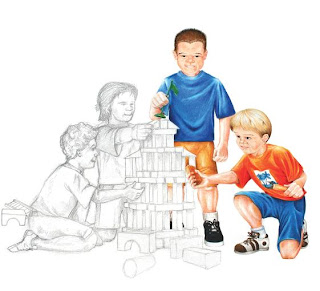Games and fun stuff to promote communication
Children get sick of being asked to talk or “perform” and may refuse, especially if your request for language seems purposeless to them. Games are a fun way for children to learn without even knowing they are learning. Newton (2004) discusses some key things to think about when deciding on what games to play. I discuss some of these below. But the key thing to remember is that, while learning to label things is important:
“Action words are more important than nouns or names because they are far more useful. Names can only be used for labelling.” p113
Sounds or words?
Words will be meaningless sounds to our children if we don’t help them understand those sounds. Some fun ways to help children recognise the meaning include:
* Sorting games – to help children recognise colours and understand descriptive words such as big and small, wet and dry, play sorting games. This could be a simple as getting them to find all the blue pegs while you are hanging the clothes on the line. Or sorting counters during Maths activities at school.
* Nonsense words – one of the things I use to prompt reluctant talkers to get involved is use nonsense or incorrect words to label or describe things that you are pretty sure the child is able to identify. For example, when reading a book identifying a dog as an elephant. Or if the child is requesting something, make wildly incorrect, humorous guesses until they correct you. And, from my experience, it usually brings laughter as well as the desired communication.
Which comes first? The request or the manners?
Newton (2004) suggests that it is much more important that your child learn to request something (eg. drink, biscuit) than learning “please” and “thank you”. However, once they have mastered the requesting, then you might want to teach these words. Some fun ways to expand on your child’s ability to request items:
* Hide and seek using an object – This will give you an opportunity to model and prompt requests.
* Sharing toys – play games where you limit the number of toys available so that you and your child, or the child and other children, have to request items and take turns. Or put toys just out of reach so that your child needs to ask for them.
Dramatic play, puppets and soft toys
Acting out every day activities in dramatic play can really help expand children’s language. Puppets, dolls and soft toys can also be a front behind which a child can “hide” if they are reluctant talkers. A child who will not talk with others may sit for hours “chatting” to or through their dolls, puppets and soft toys.
* Shopping – just like with many of us adults, shopping can be a favourite with children. Set up a sales counter, use picnic sets, toys, empty cartons and play money and you will have many opportunities for speech. In this game children will need to request things. You can also help them with counting and other phrases that might be used in real life shopping experiences. Also, take every opportunity to describe what you, other children or the child is doing.
* The sandpit – playing in a sandpit will also product a lot of opportunities for communication. Building roads, castles, villages, cakes…. So many different opportunities for requesting and describing activities will be made.
* Cubby houses – cubby houses also seem to be one of those things that hold their appeal across the ages. And some of the most exciting, communication producing cubbies are the ones built out of mum’s bedspread, pillows, chairs, the dining table etc. Again, requesting, describing and using useful “real life” language in a pretend setting can help increase children’s communication abilities.
Cooking together
There are some household or life activities that lend themselves to helping children communicate. Cooking is one of these. It provides you with opportunities to describe what you are doing, talk about the ingredients, request items and so on.
Drawing and craft
Drawing, painting and craft projects are also productive of similar opportunities as described for the cooking activities. Here are some tips:
* Rather than guess what your child has drawn, try saying “Tell me about your picture.” Write down what the child says, either on the back or on the picture itself, so you can read it together and talk about it again another time.
* As you do these activities, talk about what you are doing. Eg, “Snip, snip! We are cutting in a straight line!”
Giving instructions
Play games where children provide instructions verbally. For example, Simon says (replacing “Simon” with the child’s name), treasure hunts, obstacle courses. But make sure you have pictures and gestures lined up for the child to use as well as language if they are struggling with their words.
… But most of all, have fun LoL





















